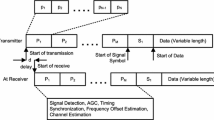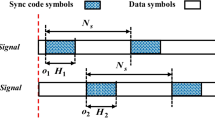Abstract
Pilot symbol assisted modulation (PSAM) is amethod to reduce the effects of fading in mobilecommunications by periodically inserting knowing symbolsin the data stream. The receiver uses the pilot symbols to estimate channel state information. In orderto do this, the pilot symbols must first be located inthe noisy received sequence. This paper investigates theperformance of a class of PSAMs frame synchronizers which have the form of a quadratic correlationfilter and threshold test. Computer simulations are usedto show that these synchronizers can be designed to havea robust performance over a large range of Doppler spreads and SNR, to achieve anarbitrarily high probability of correct acquisition, andto maintain low computational complexity.
Similar content being viewed by others
REFERENCES
A. Aghamohammadi and H. Meyr, A new method for phase synchronization and automatic gain control for linearly modulated signals in frequency flat fading, IEEE Trans. Commun., Vol. COM-38, pp. 25–29, 1991.
M. L. Moher and J. H. Lodge, TCMP-a modulation and coding scheme for Rician fading channels, IEEE Trans. Select. Area Commun., Vol. SAC-7, pp. 1347–1355, 1989.
S. Sampei and T. Sunaga, Rayleigh fading compensation for QAM in land mobile radio communications, IEEE Trans. Vehicular Tech., Vol. VT-42, pp. 137–147, 1993.
J. K. Cavers, An analysis of pilot symbol assisted modulation for Rayleigh fading channels, IEEE Trans. Vehicular Tech., Vol. 40, pp. 686–693, 1991.
J. L. Massey, Optimum frame synchronization, IEEE Trans. Commun., Vol. COM-20, pp. 115–119, 1972.
P. T. Nielsen, Some optimum and suboptimum frame synchronizers for binary data in Gaussian noise, IEEE Trans. Commun., pp. 770–772, 1973.
G. L. Lui and H. H. Tan, Frame synchronization for Gaussian channels, IEEE Trans. Commun., Vol. COM-35, pp. 818–829, 1987.
P. Robertson, Maximum likelihood frame synchronization for flat fading channels, ICC, Vol. ICC-92,No. 5, pp. 1426–1430, 1992.
A. Polydoros and C. L. Weber, A unified approach to serial search spread-spectrum code acquisition-Parts I & II, IEEE Trans. Commun., Vol. COM-32, pp. 542–560, 1984.
W. C. Jakes, Microwave Mobile Communications. New York: Wiley, 1974.
J. K. Cavers, On the validity of the slow and moderate fading models for matched filter detection of Rayleigh fading signals, Canadian Journal of Electrical and Computer Engineering, Vol. 17, pp. 183–189, 1992.
R. A. Horn and C. R. Johnson, Matrix Analysis. New York: Cambridge University Press, 1990.
M. P. Fitz, J. V. Krogmeier, J. Grimm, J. A. Gansman, T. M. Magnusen, and T.-A. Chen, The 220MHz ITS spectral allocation: Potential, pitfalls, and applications, IEEE Communications Magazine, Vol. 34, pp. 42–54, 1996.
Rights and permissions
About this article
Cite this article
Gansman, J.A., Fitz, M.P. & Krogmeier, J.V. A Comparative Synchronizers Study of a Class of PSAM Frame. International Journal of Wireless Information Networks 4, 7–20 (1997). https://doi.org/10.1023/A:1018825520617
Issue Date:
DOI: https://doi.org/10.1023/A:1018825520617



